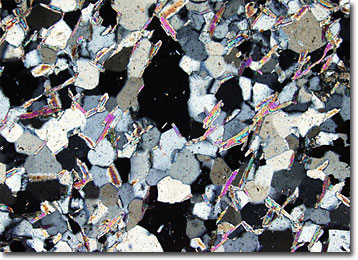Polarized Light Microscopy Digital Image Gallery
Kyanite Quartzite
Sometimes alternatively referred to as disthene, kyanite appears as long, bladelike crystals that range from white to gray, black, or blue in color. The azure shades of some samples can be quite beautiful, and, in fact, the mineralís most commonly utilized name stems from the Greek word kyanos, meaning "blue."

Kyanite is an aluminum silicate mineral that occurs primarily in schists and gneisses, often in association with quartz, mica, or garnet. Similar to many other minerals, attractive specimens of kyanite are sometimes cut into gemstones. The substance is perhaps more commercially important, however, as a source of mullite, a raw material utilized in refractory ceramics applications. Some of the most notable occurrences of kyanite can be found in the New England area of the United States, the Urals of Russia, and Trentino, Italy.
One of the most abundant minerals in the Earthís crust, quartz occurs in almost all rocks and has even been found in samples taken from the moon. A type of rock that is solely or primarily composed of quartz is known as quartzite. Predominantly formed from the metamorphism of sandstone, quartzite varies in color, but is typically white, pink, or gray. Large masses of quartzite, which are resistant to erosion, can frequently be observed in the form of mountains and hills. The rock is often quarried as a source of silica and also garners use as building material.
